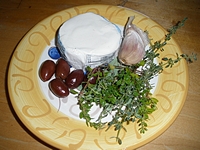Fresh thyme in the herb garden is so abundant in July.
And simple recipes that feature fresh herbs and don’t require turning on the stove are a real treasure.
This lovely and simple thyme and goat cheese recipe is just that. Both elegant enough to serve at a dinner party, and casual enough to enjoy as an afternoon snack, there is no cooking involved.
And the recipe takes full advantage of the abundance of the wonderfully fragrant herb thyme.
I first had this marinated goat cheese and thyme spread when one of my fellow taiko drummers brought the thyme infused goat cheese to a rehearsal. I was blown away by how addictively good the flavours were — I couldn’t stop eating it.
So, of course I asked for the recipe. When she sent me the recipe, I was even more blown away by how simple this dish is to make.
Hope you enjoy it as much as I do.
Marinated Goat Cheese Recipe
8 oz. goat cheese
6 tablespoons olive oil
3 tablespoons balsamic vinegar
½ cup kalamata olives, chopped
2 cloves garlic, minced
1 tablespoon fresh thyme, chopped
1 teaspoon black pepper
Fresh thyme sprigs for garnish
1. Place the goat cheese in a shallow container.
2. Mix together olive oil, balsamic vinegar, chopped olives, garlic, thyme and pepper.
3. Pour this mixture over the goat cheese, keeping as many of the olives on top of the cheese as you can.
4. Allow the goat cheese to sit in the refrigerator for 6 hours, or 2 hours at room temperature, to marinade. Occasionally spoon the marinade over the goat cheese.
5. Just before serving, place the fresh thyme sprigs on top of the marinated goat cheese for garnish.
6. Serve with a sliced baguette, crackers, or any good French or Italian style bread.
Tips:
1. 8 oz. equals approx. 227 grams. You can use 2 pieces of 1” thick rounds of French chevre, 2 small logs of goat cheese, or 1 large log of goat cheese (200 gram – 300 gram size).
2. Because this dish is not cooked, the flavours of the fresh ingredients are paramount. Make sure you use a good quality olive oil and a good quality balsamic vinegar.
3. You can make this recipe the night before. The complex flavours of this dish really develop nicely as the goat cheese sits in this thyme and garlic infused dressing.
4. In a pinch, you can make the recipe without the marinating time. I have made this spread last-minute on more than one occasion. The end product was not as complex – more garlicky and less thyme flavor throughout, but still very good.
5. If you’re making this dish for a party, make an extra one for yourself for the following day.
Then, In the middle of the sweltering afternoon heat, pour yourself a glass of wine, or chilled sparkling water, pull out the thyme and goat cheese spread with some fresh bread. Relax, and enjoy the afternoon.
To your herb garden success,
Herb Garden Gal
Copyright © 2011 www.HerbGardenGal.com. All rights reserved.
_________
Want to use this article in your Ezine or Website? You can, as long as you include the complete article and the Copyright information.

